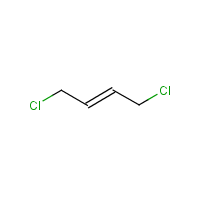1,4-Dichloro-2-butene
Agent Name
1,4-Dichloro-2-butene
CAS Number
764-41-0
Formula
C4-H6-Cl2
Major Category
Other Classes

Synonyms
1,4-DCB; 1,4-Dichloro-2-butylene; 1,4-Dichlorobutene-2; 2-Butene, 1,4-dichloro-; 2-Butylene dichloride; 1,4-Dichlorobut-2-ene; [ChemIDplus] UN2920
Category
Halogenated Aliphatics, Unsaturated
Description
Colorless liquid with a sweet, pungent odor; [HSDB] Yellowish liquid; [OECD SIDS]
Sources/Uses
Used as an intermediate in chemical manufacturing; [HSDB] Continuously manufactured and processed in closed systems and essentially used 100% as an intermediate; [OECD SIDS]
Comments
Highly toxic; [Quick CPC] When heated, decomposes to toxic gases: phosgene and HCl; High inhalation exposure can cause pulmonary edema; [HSDB] Skin contact with liquid causes severe blistering; [CHRIS] Induces genetic damage in germ cells of humans or animals (3A); [MAK] Reacts with water forming hydrochloric acid; Vapor is irritating to nose and throat; Highly irritating to skin (blistering) and eyes (lachrymation); [CAMEO] Generally available in the US as a mixture of 95-98% trans- (CAS# 110-57-6) and 2-5% cis- (CAS#1476-11-5) isomers; [OECD SIDS] Causes burns and lachrymation; Inhalation may cause corrosive injuries to upper respiratory tract and lungs; Highly toxic by inhalation; Toxic by ingestion and skin absorption; [Aldrich MSDS] See "1,4-Dichloro-trans-2-butene."
Biomedical References
Exposure Assessment
Skin Designation (ACGIH)
Yes
TLV (ACGIH)
0.005 ppm
Vapor Pressure
3 mm Hg
Lethal Concentration
LC50 (rat) = 86 ppm/4hr
Explanatory Notes
LC50 (rat) = 450 mg/m3/4hr; [OECD SIDS] The Guide in the Emergency Response Guidebook is for "Dichlorobutene." VP from HSDB;
Adverse Effects
Lachrymator
Yes
Toxic Pneumonitis
Yes
Dermatotoxin
Skin burns
ACGIH Carcinogen
Suspected Human
Diseases, Processes, and Activities Linked to This Agent
Other Information
No other related information on this agent was found.